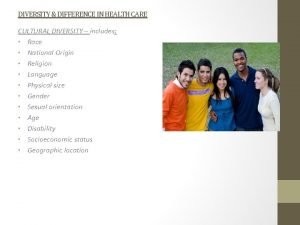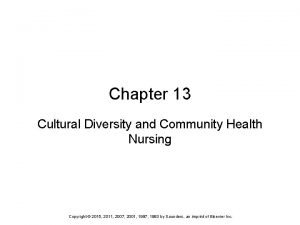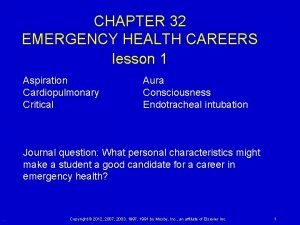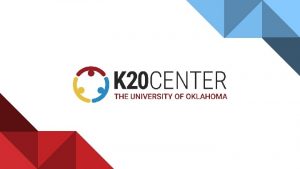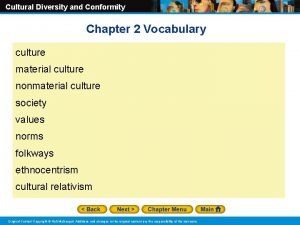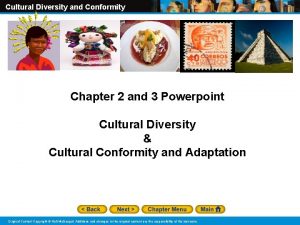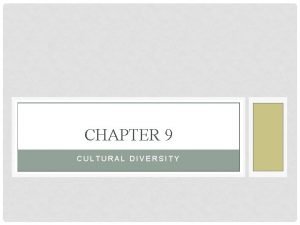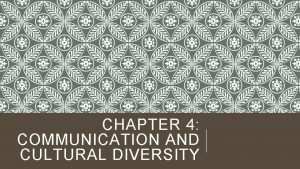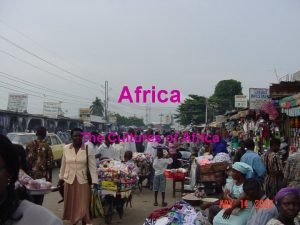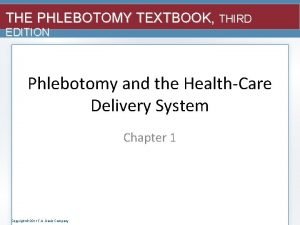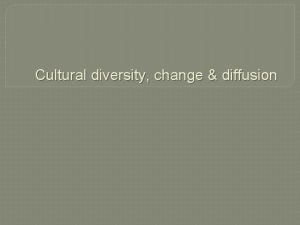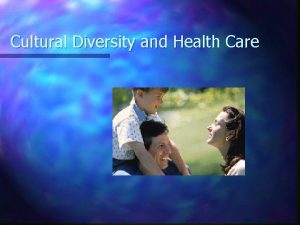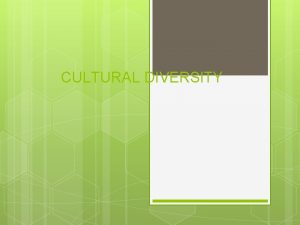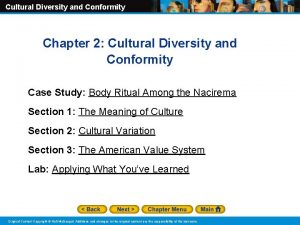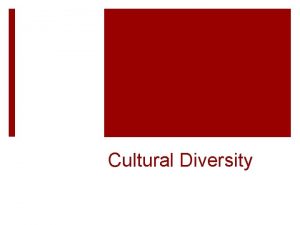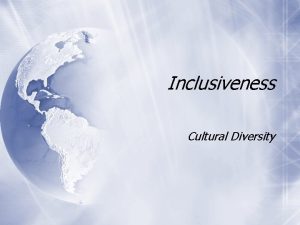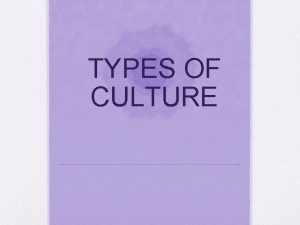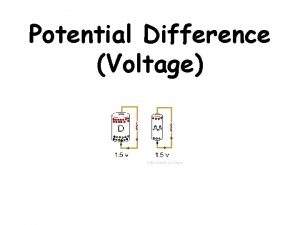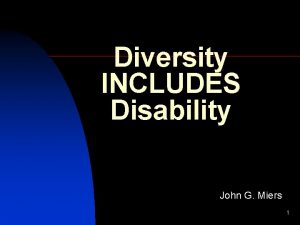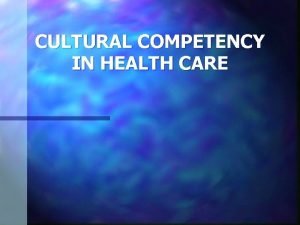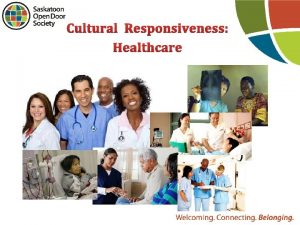DIVERSITY DIFFERENCE IN HEALTH CARE CULTURAL DIVERSITY includes



















- Slides: 19

DIVERSITY & DIFFERENCE IN HEALTH CARE CULTURAL DIVERSITY – includes: • Race • National Origin • Religion • Language • Physical size • Gender • Sexual orientation • Age • Disability • Socioeconomic status • Geographic location

Personal beliefs • Patients & providers each have their own beliefs & values which impact personal principles • Some influences include: • Cultural beliefs • Social beliefs • Religious beliefs • Personal convictions • Ethnocentrism –should be avoided by health care workers • - Stereotypes – mistaken perceptions that are typically rooted in strong feelings and a lack of knowledge • Differences among people should be appreciated and respected.

CULTURAL & ETHNIC DIFFERENCES • Culture – a shared system of beliefs, values, and behavioral expectations that provide structure for daily living • • • Factors Influencing Culture Beliefs Habits Likes dislikes Customs Rituals

FACTS About Culture: • Helps provide a shared identity for cultural groups • Influences member’s view of self, expectations, & how they behave in response to certain situations • Practices can be shaped by social & physical environment • Each new generation learns the norms, or expected behaviors of its culture through language, formal teaching, observation of elders • Culture is made up of individuals – this means differences within each culture – HCP must not assume every member of a particular culture or ethnic group is exactly the same……

Subculture • Group of people who are members of a larger cultural group – but whose attitudes/beliefs differ form the main group/culture • ETHNICITY • Sense of identification based on a common heritage through birth – adoption of group’s characteristics • RACE • Based on specific physical characteristics • - skin pigmentation, body stature, facial features, hair texture • Whites – African Americans-American Indians- Alaska natives – Asian Americans – native Hawaiians and other Pacific islanders(census cat. ) • Dominant Group – tends to control the society’ s values • Minority Group – usually some difference that separates them from DG • -race-religion – beliefs – customs/practices

Cultural Assimilation or ACCULTURATION • Group loses cultural characteristics that once made them different • They adopt attitudes of a group or new country • Culture shock • - can produce stress, feel foolish, fearful, embarrassed , inferior • - these feelings lead to frustration, anxiety, loss of self-esteem

PHYSICAL CHARACTERISTICS • Some diseases that are/may be hereditary: • Tay-Sachs Disease - rare genetic disorder • • • - progressively destroys nerve cells in brain & spinal cord - Infants – normal first few months- but develop inability to move and eventually die • • - incidence has declined due to genetic testing - Eastern European Jewish descent

KELOIDS • • • -Overgrowth of connective tissue - Forms during healing from injury to skin - Does not heal level – heals rough, lumpy, or elevated scar - People with dark skin - more likely to develop - Seems to run in families which suggest genetic cause

LACTASE DEFICIENCY – (Lactose Intolerance) • • - all mammals milk contains lactose(a sugar) • - Body needs lactase to breakdown lactose during digestion • - w/o lactase – lactose ferments in intestine • Lactase deficiency & lactose intolerance more common among: • - Hispanic women & men • - women of African, Chinese, Thai descent - People w/ lactase deficiency can drink milk substitutes or dairy products enriched w/ lactase

SICKLE-CELL ANEMIA • • • - - Hereditary disorder - body makes sickle-shaped or c-shaped red blood cells - breakdown more rapidly - shape prevents movement into smaller vessels in the body - can cause a blockage of red cells – - Primary groups affected: People of African descent -Hispanics of Caribbean ancestry Individuals w/ Middle Eastern, Indian, Latin American, Native American, or Mediterranean heritage

Psychological Characteristics • • • People evaluate each other – attitude/behavior HP view can differ from patients view Patients concerns are very real to the patient – do not dismiss People interpret behaviors differently - standing close to someone - casual touch or direct eye contact

Reactions to pain • Culturally influenced • - some allow/encourage open expression of pain • - some frown on open display • HCP needs to understand patient display of pain • - not all will complain or show • Pain is a warning from the body that something is wrong • Pain is what a person says it is & should be assessed carefully

Cultural Sensitivity for HCP • • Recognize culture is important part of an individual’ approach to the world Each person holds his/her own beliefs about health Respect the patient’s right to respond to HC issues in whatever manner they want Never stereotype a patient’s perceptions or responses based on their culture GENDER ROLES Some cultures-Males dominant and generally make decisions for family members Family confusion – who decides? ? Some cultures – women are dominant and make the decisions

Time Orientation • Americans – very - value promptness & punctuality - time perception is futureoriented • OTHER CULTURES • South Asians – some cultures view being late as sign of respect • Some cultures more concerned with the present or past • These views can impact patient care – • Example – a patient whose culture focuses on the present may have issues understanding long-term care - HCP may have to explain need • Some workers who are habitually late may be viewed as lazy/irresponsible – however – that person may be a hard worker whose culture does not value punctuality

FOOD & NUTRITION • Discuss cultural differences • France – corn is considered animal feed • Asians – rice is a staple of many diets • Southern Italians – pasta • Some Hispanics cultures – beans – not all • Mexicans – chili peppers & tortillas • Caribbean Hispanics – beans w/ rice • African Americans – fried food

Eating Patterns Based on Culture • • • White Americans – 3 meals /day = eggs/bacon – sandwich/soup meat & potatoes Vietnamese – soup with almost every meal Middle Eastern Countries – often eat cheese/olives for breakfast Native American/Latin American people usually eat only 2 meals/ day Rural Southern African Americans eat large amounts of the weekends – with less during the week • Holy days or Religious Holidays influence food choices in most cultures

Socioeconomic factors • • • Middle & Upper middle class – have access to health care Low income – generally do not Upper income groups – tend to live longer & less disability Poverty – impacts older Americans and single mom families - leads to inadequate care – infants/children - poor diet - less preventative care - some cannot afford transportation - lack affordable/adequate housing(heat- h/c water, etc) - crowded living conditions leads to spread of disease - leads to low esteem, not taking care of self

age • Younger people vs older people • - Mind set • Age, physical condition impacts health • Communication – old vs. young • As we age , body and health can change, but young people can be less healthy than older people • RELIGION • Beliefs & values will impact how HCP treat patients • How to treat, what may be allowed • Orthodox Jews may not be touched by women who are not family members • Jehovah Witnesses – consider it a sin to receive the blood of another person in a transfusion -

Folk medicine • A form of prevention & treatment that uses old-fashioned remedies & household medicines handed down from one generation to the next • Nontraditional Healing: • • Cutaneous simulation – Therapeutic touch – Acupuncture – Acupressure – • Natural remedies – herbal tea’s • Complementary/Alternative Medicine – nutrition/exercise/relaxation = preventative medicine
 Chapter 13 diversity and difference in health care
Chapter 13 diversity and difference in health care Culturological assessment
Culturological assessment Primary, secondary, tertiary care
Primary, secondary, tertiary care Health and social care unit 2
Health and social care unit 2 Health and social care component 3
Health and social care component 3 The goal of modern emergency care includes
The goal of modern emergency care includes 10 difference between health education and health promotion
10 difference between health education and health promotion Health education and health propaganda
Health education and health propaganda Genetic diversity and biodiversity
Genetic diversity and biodiversity Ecosystem jigsaw activity
Ecosystem jigsaw activity Salad bowl culture
Salad bowl culture Synergism is a term popularized by buckminster fuller
Synergism is a term popularized by buckminster fuller Cultural diversity and conformity section 3
Cultural diversity and conformity section 3 Cultural diversity and conformity section 3
Cultural diversity and conformity section 3 Chapter 9 cultural competence
Chapter 9 cultural competence Chapter 4 communication and cultural diversity
Chapter 4 communication and cultural diversity Cultural diversity examples
Cultural diversity examples Chapter 10 cultural diversity
Chapter 10 cultural diversity East africa has great cultural diversity because of its -
East africa has great cultural diversity because of its - Cultural diversity in phlebotomy
Cultural diversity in phlebotomy
